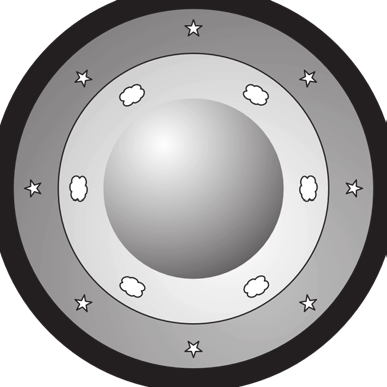The Wisdom of Hypatia: Ancient Spiritual Practices for a More Meaningful Life (32 page)
Read The Wisdom of Hypatia: Ancient Spiritual Practices for a More Meaningful Life Online
Authors: Bruce J. MacLennan

O Unity of Unities,
Thee, Thought of Thoughts, I ever sing—
Father of fathers, only Spring
Of all beginnings, Thou bidst flow
All founts, and mak’st all roots to grow;
Thee only good—who world on world
And star on star through space hast hurl’d.
Fathomless Beauty, seed unknown,
Source whence the wings of Time have flown,
Father of spirits pure, that dwell
In spheres whose place no tongue can tell.”217
“Thank you for your attention. Farewell.” As Hypatia leaves the dais, her students
lead the rest of the audience in applause.
160 the macrocosm
The God of the Philosophers
Inevitably The One, the cause of everything that
is
, was treated as a kind of deity (indeed, a supreme deity) and simply called “God.” Furthermore, in conformity with the conceptions of the age, this deity was envisioned as an anthropomorphic male god, the Father.
This terminology is treacherous, however, since it inclines us to think of God as some being behaving in time, observing human behavior, hearing prayers, making decisions, allotting punishments and rewards, and otherwise behaving like a bigger-than-life person (typically a father figure). We must remember that the Cosmic Mind is already outside the realm of time, and that Neoplatonists regard the gods, who exist at this level, to be impassive. How much more remote and abstract must The One be! This is not a God to
cozy up to, or with whom you can have heart-to-heart colloquies! Arguably, much of the appeal of Christianity, Judaism, and the popular Pagan religions as well lay in their more approachable and anthropomorphic ideas of deity.
Therefore Neoplatonist philosophers with a more religious or spiritual orientation find a more approachable concept of divinity at the level of the daimons. As I’ve explained, these beings are in the lineages of gods, but exist in time and space, and so are able to interact with people. This does not mean that the gods themselves, as Beings in the World Mind, are irrelevant, but they are impersonal dynamic forces, which engender and govern the personal daimôns in the World Soul. So if you pray to Diana and she answers, in actuality it is probably one of her daimons who takes the call. (If you are a monotheist and getting impatient with this talk of gods and daimons, think of them as angels for now. I will have more to say later.)
When considered as a religious orientation, Pagan Neoplatonism is often characterized as
henotheism
rather than
monotheism
, because it has a multiplicity of gods, but one is supreme. This is one reason, as a philosophy, it was able to accommodate the monotheistic religions (more on this in the next chapter). For example, Maximus Tyrius, a Platonist of the second century CE, expresses the henotheistic view:
In such a mighty contest, sedition and discord, you will see one according law and
assertion in all the earth, that there is one god, the king and father of all things, and many gods, sons of god, ruling together with him.218
The One, the Ultimate Good, is sometimes known as “the God of the philosophers” to
distinguish it from more popular notions of deity. Recall that “philosopher” means “lover and seeker of wisdom,” so “the God of the philosophers” does not refer to some academ-the macrocosm 161
ic theological concept, but to the understanding of divinity achieved by these seekers of wisdom.
The Inexpressible One, with its incomplete descriptions as The Good, Love, Beauty,
and God, is a concept in spiritual philosophy and theology, and we may seem to have come a long way from Forms exemplified by the objects of mathematics and the equations of physics, and from the World Soul as Nature and its processes. Can The One cohabit with a scientific worldview?
I believe that it can. If we ascend upward (or descend inward: pick your image) from the equations of physics (that is, the laws of gravity, electromagnetism, etc.: whatever the correct equations might be), conceived as the Forms governing different aspects of material reality (gravity, electromagnetism, etc.) and psychical reality (perception, motivation, behavior, the unconscious, etc.), we must encounter a Form (abstract law) governing reality as a whole (that is, not separated into different phenomena). We may not be able to express this law in discrete mathematical equations (as when the Forms are separated), but this principle of universal orderliness, of cosmos and not chaos, approaches the limit that is The One, the cause of everything. So I think that The One can be identified with the ultimate causal principle of the universe, even if it is inexpressible in mathematical equations, but it is essential that this principle be the cause of
all
phenomena in the universe, not just physical phenomena; in particular it must account for consciousness, the unconscious, and other psychical phenomena. This conception of The One could be called “the God of the scientists.”
Images of the Cosmos
There are several ways to visualize the Neoplatonic cosmos, and different ones work better in different circumstances. You may find one or more of them useful as the basis of visualization exercises. I suggest that you practice the visualizations that work best for you, since they will help to imprint the Neoplatonic cosmic map on your mind.
162 the macrocosm
The One
Noetic Plane
Phychical Plane
Physical Plane
The Planes of Reality
One way to understand the cosmos is as levels or planes of reality. The lowest is the earthly plane, on which we live. Above it is the World Soul, the realm of divine Nature and the daimons, which is the boundary or connecting link between our world and the World Mind. It is also called the
Psychical Plane
because it is the level of the soul (
psyche
in ancient Greek). The next level, the World Mind is the eternal realm of ideal Forms, including the archetypal gods; we might think of it as heaven. It is also called the
Noetic Plane
because, as will be explained in the next chapter, it is the realm of the thoughts (
noeta
) of the World Mind (
nous
). The highest plane, then, is The One, identified with God, which is absolutely simple.
The Tetractys
The ancient Pythagorean symbol called the
Tetractys
is a way of remembering this structure (see figure). At the top is one dot, which represents The One. Below it are two dots, which represent duality, and thus being/non-being, true/false, is/is-not, subject/object, thinker/thought, and thus the plane of Being, the realm of the Ideas in the World the macrocosm 163
Mind. The three dots represent the World Soul in two ways. First, because the three dots represent mediation (one dot between the other two) and the World Soul is the mediator joining the Ideal World to the Material World. Second, because the World Soul is the realm where time first appears and, according to Pythagoreans, the three dots represent the beginning, middle, and end of any process. They also represent the three dimensions of physical space. The four dots on the bottom represent the Material World by means of several symbols. For example, it can be the four elements (earth, water, air, fire), which also symbolize our world: land, sea, atmosphere, and fiery phenomena (lightning, sunlight, etc.). The four dots can also represent the four quarters of the earth (North, South, East, West), or the four seasons of the year—the cycle of Nature—and so forth. Remember this simple symbol, and you can easily recall the four planes of the Neoplatonic cosmos.
At the point where the
Pythagorean Golden Verses
turn from the practices of the second degree of wisdom to those of the third, we read:
These study, practice these, and these affect;
To sacred virtue these thy steps direct.
Eternal Nature’s fountain I attest,
Who the Tetractys on our soul impressed.219
The last two lines are the sacred oath of the Pythagoreans, which is quoted frequently (with slight variations). The philosopher swears by the sage Pythagoras, who first taught the Tetractys, which (in a slightly longer version) is described as “the fount and root of everflowing Nature.” It represents the entire outflowing of The One into material reality, the flux of coming-to-be and passing away. The Neoplatonist Hierocles, who might have attended Hypatia’s lectures, wrote this in his
Commentary on the Pythagorean Golden Verses
:
For “the fount of everflowing nature,”
the Tetractys,
is the First Cause,
not only of the Being of all things,
but likewise of their Well-being,
sowing and diffusing through the universe the Good,
innate and natural to it,
as a pure and intellectual Light.220

164 the macrocosm
The Geocentric Image
As you know, ancient people believed in a geocentric cosmos, that is, that the earth is at the center of the universe. Although we now know that the earth orbits the sun, and that the entire solar system is moving in the Milky Way galaxy, the geocentric perspective is useful for visualizing the Neoplatonic cosmos. I’ll call it the
Geocentric Image
(see figure). In the center is the earth, our material world. Surrounding it is the air (especially the luminous upper air, above the clouds), which symbolizes the World Soul that enwraps us and fills us with vital spirit (air, breath). According to ancient ideas, the daimons live primarily in the air. Above the air is the celestial realm, the heavens, where the gods dwell. Because the stars do not appear to change or move with respect to each other, they are good symbols of the impassive gods and the eternal Ideas. Indeed the forms of the constellations might have inspired geometric thinking about the Forms. Much ancient mathematics was devoted to astronomy and astrology. As I’ve mentioned, Hypatia was a highly regarded mathematician and astronomer, and her few surviving works are on these topics. The highest heaven, the black void behind the visible stars, symbolizes The Inexpressible One, with its ineffability, infinity, and impenetrability. Therefore you can go outside on a starry night and experience the Neoplatonic Cosmos, as Hypatia might have done with her own students.
Geocentric Image



